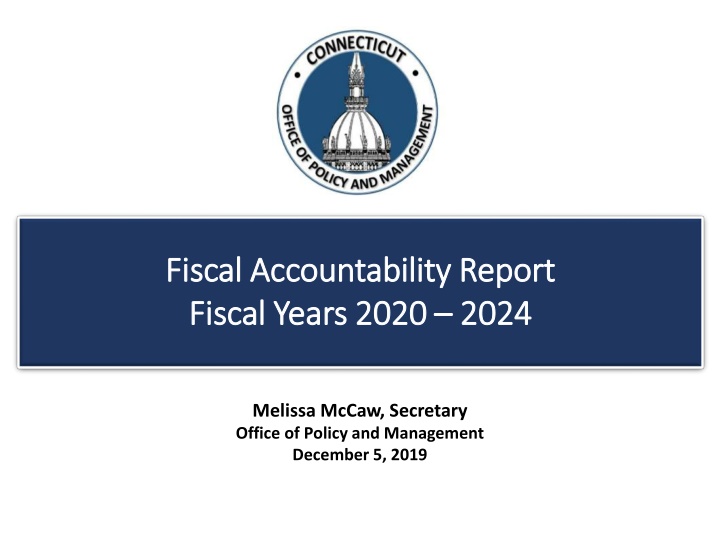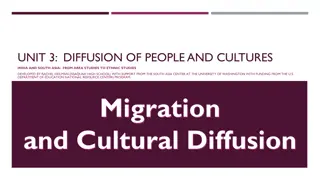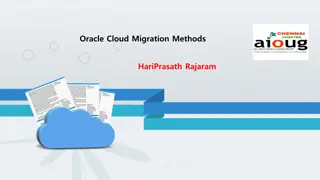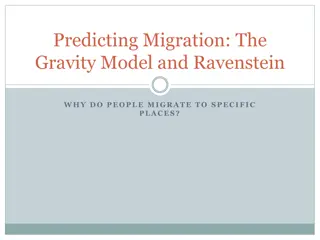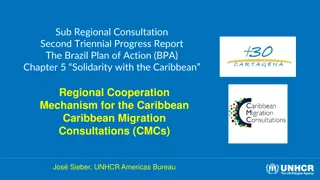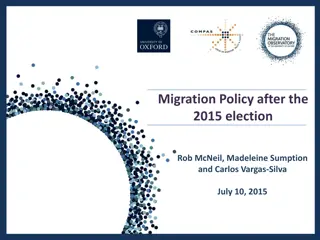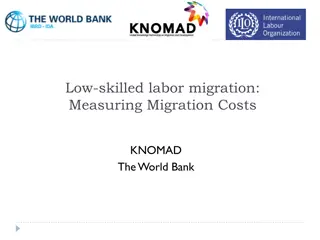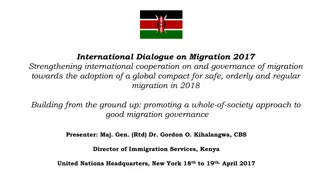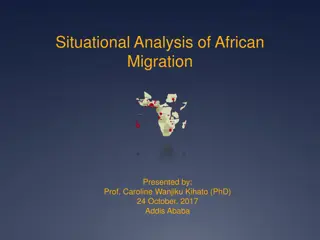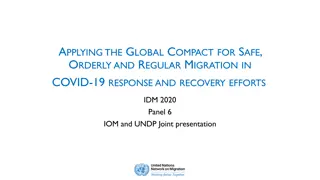Addressing International Migration Challenges in Africa
Addressing the challenges of international migration in Africa involves understanding the motivations behind migration, the economic implications for both origin and destination countries, and the prevailing migration trends within the continent. Despite common misconceptions, a significant portion of African migrants relocate within their sub-regions rather than to Europe. The presentation by Takyiwaa Manuh at the Committee of Experts meeting in Addis Ababa delves into these critical issues and sheds light on the complexities of international migration in Africa.
Download Presentation

Please find below an Image/Link to download the presentation.
The content on the website is provided AS IS for your information and personal use only. It may not be sold, licensed, or shared on other websites without obtaining consent from the author.If you encounter any issues during the download, it is possible that the publisher has removed the file from their server.
You are allowed to download the files provided on this website for personal or commercial use, subject to the condition that they are used lawfully. All files are the property of their respective owners.
The content on the website is provided AS IS for your information and personal use only. It may not be sold, licensed, or shared on other websites without obtaining consent from the author.
E N D
Presentation Transcript
Fiscal Accountability Report Fiscal Accountability Report Fiscal Years 2020 Fiscal Years 2020 2024 2024 Melissa McCaw, Secretary Office of Policy and Management December 5, 2019 1
Presentation Overview 1. Budget Reserve Fund status 2. Summary of OPM projections of fixed cost growth vs. revenue growth 3. Economic factors and revenue trends 4. Long-term obligations and other topics 2
Presentation Overview Reduced revenues in FY 2022 relative to FY 2021, driven by enacted revenue policies, will be the primary driver of out-year budgetary imbalance Fixed cost growth, including increases related to long- term liabilities and entitlement spending, will continue to affect state budgetary decisions beyond FY 2021 Revenue growth has downshifted since the end of the financial crisis The potential for a national recession demands a cautious approach to budgetary policy and preservation of the Rainy Day Fund 3
Budget Growth Rates All Funds Growth Rates Average = 4.2% Average = 2.6% Average = 2.3% Average = 4.7% 10% 8.4% 8% 6.4% 6.4% 6.3% 6.2% 5.6% 6% 5.7% 5.4% 4.6% 4.7% 5.2% Expenditure Growth Rate 4.1% 3.8% 3.7% 4.9% 4% 3.9% 3.2% 3.1% 3.0% 2.4% 3.5% 2.2% 2% 1.2% 0.9% 0% -0.7% -2% -2.0% -4% 1996 1997 1998 1999 2000 2001 2002 2003 2004 2005 2006 2007 2008 2009 2010 2011 2012 2013 2014* 2015 2016 2017 2018 2019 2020 2021 Adpt. Adpt. Fiscal Year Average represents the compound annual growth rate of each shaded section *2013 to 2014 growth has been adjusted to reflect the net budgeting of Medicaid. 4
Budget Reserve Fund History and Forecast Budget Reserve Fund Balance (In Millions) $3,700 $3,400 $3,127.9 $2,973.1 $3,100 $2,823.8 $3,044.6 $2,800 $2,930.6 $2,505.5 $2,500 $2,200 15% threshold attained $1,900 $1,600 $1,381.7 $1,381.7 $1,320.2 $1,381.7 Millions $1,300 $1,185.3 $1,112.5 $1,000 $666.0 $519.2 $700 $972.4 $406.0 $302.2 $363.9$446.5$269.2 $270.7 $318.3 $212.9 $400 $93.5 $106.8$42.5$71.5$83.3 $103.2 $0.0 $0.0 $100 $235.6 $0.0 $0.0 $177.2$248.5-$113.2-$170.4 $0.0 -$200 -$22.7 -$103.2 -$500 -$800 Deposits/(Withdrawals) -$1,100 Account Balance -$1,400 -$1,278.5 '03 '04 '05 '06 '07 '08 '09 '10 '11 '12 '13 '14 '15 '16 '17 '18 '19 '20 '21 Proj. '22 Proj. '23 Proj. '24 Proj. Proj. Fiscal Year Outyear forecast assumes balanced budgets are enacted that adhere to the revenue, spending, and volatility caps. Projected balance reaches 15% in FY 2021, resulting in estimated deposits to SERS/TRS of $321.2 million in FY 2021, $442.6 million in FY 2022, $438.6 million in FY 2023, and $455.1 million in FY 2024. 5
Budget Reserve Fund Forecast Budget Reserve Fund Projections (In Millions) BRF Limit Transfer to SERS/TRS $ (321.2) (442.6) (438.6) (455.1) Fiscal Year 2019 2020 2021 2022 2023 2024 Beginning Balance 1,185.3 $ 2,505.5 2,823.8 2,930.6 2,973.1 3,044.6 Volatility Cap Transfer $ Revenue Cap Transfer $ Surplus/ (Deficit) 370.5 $ Ending Balance 2,505.5 $ 2,823.8 2,930.6 2,973.1 3,044.6 3,127.9 % of Net Appropriations 13.0% 14.1% 15.0% 15.0% 15.0% 15.0% 949.7 318.3 276.6 287.7 259.2 229.4 - - - - - - - - - 151.5 197.3 250.9 309.1 Totals: $ 2,320.8 $ 908.8 370.5 $ (1,657.4) $ Under current law (CGS Sec. 4-30a), unappropriated surpluses and volatile revenues above a certain threshold are committed to the Budget Reserve Fund until reaching the maximum 15% authorized by law. Once the 15% maximum is reached, surplus funds are directed toward: Reducing the unfunded liability of the State Employees Retirement Fund Reducing the unfunded liability of the Teachers Retirement Fund Reducing bonded indebtedness 6
Overdue for a Recession National Economic Expansions* Length in Months (as of October 2019) 1949 45 Average: 60.5 months (1949 - 2001) 1954 39 1958 24 1961 106 1970 36 1975 58 1980 12 1982 92 1991 120 2001 73 2009 124 0 20 40 60 80 100 120 140 * Includes recovery and expansion months Source: National Bureau of Economic Research Months The current economic expansion is the longest since the end of World War II. 7
Consequences of an Insufficient Budget Reserve Fund 2008 Recession Connecticut's Response to the 2008 Economic Downturn Revenue Measures and Deficit Financing Implemented FY 2009, FY 2010, FY 2011, FY 2012 (in millions) Fiscal 2009 $ Fiscal 2010 1,278.5 $ 878.9 845.0 108.5 Fiscal 2011 103.2 $ 960.4 586.7 104.0 280.7 Fiscal 2012 $ 2,417.7 111.6 (97.9) 253.4 % of Total 14.3% 23.2% 39.7% 3.3% 3.3% 6.7% 9.5% 100.0% Revenue Measure 1. Deplete Budget Reserve Fund 2. Federal Assistance-ARRA 3. Tax Increases 4. Fee Increases 5. Fund Sweeps 6. Other Revenue Measures 7. Economic Recovery Notes (ERNs) Total 1,381.7 $ 2,247.0 3,849.4 324.1 319.5 649.1 915.8 - - - 407.7 - - 250.8 18.3 915.8 89.8 96.7 - 76.9 - - Total 1,592.6 $ 3,297.4 $ 2,111.9 $ 2,684.8 $ 9,686.6 $ Note: According to the National Bureau of Economic Research (NBER), the 2008 economic downturn began in December 2007 and ended June 2009. In aggregate, it took approximately $9.7 billion in revenue measures, including federal ARRA assistance and deficit financing, to help address budgetary imbalance. This sum does not include significant spending cuts that were implemented! 8 Federal ARRA assistance included $1.6 billion in enhanced Medicaid and Title IV-E matching funds and $540.0 million in education support ( State Fiscal Stabilization Fund )
Consequences of an Insufficient Budget Reserve Fund 2008 Recession Spending cuts frequent and significant $314.5 million in reduced contributions to SERS, exacerbating the already low funded status of the pension fund ($50 million in FY 2009, $164.5 million in FY 2010, and $100 million in FY 2011) 2009 Retirement Incentive Plan - $147.5 million in near- term savings, but further strained the pension fund Employee concessions in 2009, 2011 and 2017 Multiple deficit mitigation plans enacted (table at right) Reductions to all aspects of the budget, including: municipal aid human services private providers arts and tourism Substantial and repeated reductions to discretionary spending via rescissions (table below) Deficit Mitigation Legislation Spending Cuts* ($M) Session Year 2008 PA 08-1, Nov. SS $25.6 2009 PA 09-1 $44.2 2009 PA 09-1, Dec. SS $12.4 2010 PA 10-3 $89.6 2010 PA 10-2, June SS Net zero 2012 PA 12-1, Dec. SS $221.5 2015 PA 15-1, Dec. SS $214.3 2016 PA 16-1 $150.8 2017 PA 17-51 $2.3 Rescissions FY09 FY10 FY12 FY13 FY15 FY16 FY17 # of Occasions 5 2 1 1 3 2 1 Total ($M) $201.6 $51.1 $78.7 $170.4 $99.9 $181.5 $77.2 9 * Source: OFA fiscal notes
Reasons to Preserve the Budget Reserve Fund Moody s Analytics - October 2019 report regarding state preparedness to withstand fiscal stress Recession Scenario Required Reserves CT s Preparedness Moderate 10.1% Relatively well-positioned (ranked 18th of the 50 states) Severe 14.8% Insufficient resources without having to raise taxes or cut spending (ranked 21st of the 50 states) How policymakers prepare for downturns matters a great deal in the pace of economic recovery. Unpreparedness can lead to disruptive decisions to drastically cut spending or raise revenues just at the time the economy can least afford it. Preparedness, on the other hand, can lend stability to a struggling economy and help conditions recover more quickly. (p. 9) 10
Reasons to Preserve the Budget Reserve Fund The Moody s analysis attempts to adjust for state variances, but Connecticut has reasons for a conservative approach to recession-readiness: Highly progressive (and therefore more volatile) personal income tax structure Heavy reliance on personal income tax as a proportion of all state revenues (approx. 50% of General Fund), and therefore on the economic fortunes of extremely high-wealth taxpayers Relatively high fixed costs (debt, pension, OPEB) 11
Reasons to Preserve the Budget Reserve Fund At least $1.3 billion of the $2.5 billion BRF balance is due to one-time, non-repeatable factors: $750 million from repatriation of overseas hedge fund deferred profits IRS Code 457A required repatriation of overseas hedge fund profits by December 31, 2017 for activity that had occurred prior to 2008 when the federal government disallowed sheltering of such income One time revenue for economic activity that occurred a decade or more ago $570 million from the initial proceeds of the new Pass-through Entity Tax (PET) CT passed the PET in response to federal capping of the SALT deduction FY 2019 was the first year of collections and initial estimates were based on conservative budgeting and also did not fully account for 18 months of payment estimated payments for 2 income years, and final payment for 1 income year Additionally, some (inestimable) revenue related to repatriation of overseas deferred profits under the Tax Cuts and Jobs Act of 2017 TCJA required individuals and businesses to pay a transition tax on untaxed foreign earnings as if those earnings had been repatriated to the U.S., generally affecting income year 2017 (SFY 2018) 12
Difficult Choices for Aligning General Fund Revenue and Expenditure Growth Total FY 2020 General Fund Appropriations = $19,319.1 million* All Other Programs, $842.9 million, 4.4% Other Expenses and Equipment, $503.2 million, 2.6% Debt Service (incl POB), $2,233.0 million, 11.6% Other HHS Programs (incl DCF, DOH, and DVA), $2,164.6 million Salaries and Wages, $3,071.4 million Health and Human Services Programs 28.0% Active and Retired State Employee Wages and Benefits 31.7% Medicaid (incl Hosp Supplement), $3,253.9 million Employee Healthcare, $645.1 million Other Fringe Benefits, $360.0 million Retiree Healthcare and OPEB Match, $857.7 million Municipal Aid (Incl. Teachers Retirement Costs) 21.7% SERS, $1,195.7 million Municipal Aid, $2,951.4 million * Distribution by category estimated based on historical TRS Pension and OPEB, $1,240.3 million * Distribution by category estimated based on historical patterns 13
Summary of OPM Projections of Fixed Cost Summary of OPM Projections of Fixed Cost Growth vs. Revenue Growth Growth vs. Revenue Growth 14
Projected FY 2020 Operating Results FY 2020 - General Fund (in millions) Budget Plan 19,460.2 $ 19,319.1 $ 141.1 $ OPM Est. 11/20/19 19,375.7 $ 19,395.3 $ $ Change $ $ (160.7) $ Revenue Expenditures Est. Balance from Operations - 6/30/20 (84.5) 76.2 (19.6) FY 2020 - Special Transportation Fund (in millions) Budget Plan OPM Est. 11/20/19 Change Beginning Balance $ 315.1 $ 320.1 $ 5.0 Revenue 1,749.1 $ 1,732.7 $ $ (16.4) Expenditures 1,710.3 $ 1,705.9 $ $ (4.4) Est. Balance from Operations - 6/30/20 $ 38.8 $ 26.8 $ (12.0) Est.Fund Balance - 6/30/20 $ 353.9 $ 347.0 $ (6.9) 15
FY 2020 Projected Deficiencies General Fund Agency Amount Dept. of Emergency Services and Public Protection $5,000,000 Dept. of Social Services $19,200,000 Office of Early Childhood $1,800,000 Dept. of Correction $13,000,000 Comptroller Fringe Benefits $12,000,000 DAS Workers Compensation Claims $500,000 Total General Fund $51,500,000 Special Transportation Fund Agency Amount Dept. of Transportation $5,000,000 Comptroller Fringe Benefits $2,000,000 Total Special Transportation Fund $7,000,000 16
FY 2021 FY 2024 Financial Summary Year-Over-Year Revenue Growth vs. Fixed Cost Growth YEAR-OVER-YEAR REVENUE GROWTH vs. FIXED COST GROWTH (in millions) (in millions) FINANCIAL SUMMARY GENERAL FUND FY 2021 vs. FY 2020 818.8 $ FY 2022 vs. FY 2021 (459.6) $ FY 2023 vs. FY 2022 336.5 $ FY 2024 vs. FY 2023 534.8 $ Revenue Growth Fixed Cost Growth Debt Service State Employee Pensions Teacher Pensions State and Teachers OPEB Medicaid Other Entitlements Total Fixed Cost Growth Difference $ 90.1 96.6 41.1 30.6 158.2 33.1 449.6 369.2 $ 147.8 114.6 101.9 31.1 100.9 31.3 527.7 (987.3) $ 246.9 112.2 120.9 33.0 119.8 24.4 657.2 (320.8) $ 63.8 14.0 122.2 (9.8) 147.2 28.1 365.4 169.4 Fixed costs are rising faster than revenue growth in FY 2022 and FY 2023, but SPECIAL TRANSPORTATION FUND revenue growth is expected to overtake the growth in fixed costs in FY 2024. 17 FY 2021 vs. FY 2020 145.2 $ FY 2022 vs. FY 2021 128.7 $ FY 2023 vs. FY 2022 110.7 $ FY 2024 vs. FY 2023 $ Revenue Growth 26.7 Fixed Cost Growth Debt Service State Employee Pensions and OPEB Total Fixed Cost Growth Difference $ 80.9 8.4 89.2 56.0 $ 38.3 13.6 51.9 76.8 $ 48.5 13.3 61.8 48.9 $ 48.6 (1.5) 47.1 (20.4)
Revenue Growth vs. Fixed Cost Growth FY 2020 - FY 2024 Compound Annual Growth Rate 6.0% 4.8% 5.0% 4.0% 3.0% 2.4% 2.0% 1.0% 0.0% Revenue Fixed Costs Revenue = economic growth rate 18
Explaining the Change in General Fund Revenue from FY 2021 to FY 2022 (in millions) 20,194.5 $ (183.6) (380.1) 1. Estimated FY 2021 Revenues 2. Cap Teachers' Pension Exemption from 25% to 50% 3. Pension and Annuity Exemption from 42% to 56% 4. Increase in Car Sales Tax to STF from 25% to 75% 5. MRSA Transfer of Sales Tax Revenue Commences 6. Expiration of 10% Surcharge 7. Phase-in Capital Stock Tax from 2.6 mills to 2.1 mills 8. Phase-in Federal Estate Tax Exemption Level from $5.1M to $7.1M 9. Ban Plastic Bags 10. Revert Eligibility of Property Tax Credit to Prior Levels 11. Loss of the Banking Fund Transfer 12. Resume Payment Toward GAAP Deficit in FY 2022 13. Loss of One-Time 2020 to 2021 Revenue Transfer (8.0) (16.4) (15.0) (9.5) (13.2) (6.0) (53.0) (5.2) (85.1) (85.0) 14. Total Policy Changes 15. Revenue Growth $ (860.1) 400.5 16. Estimated FY 2022 Revenues 19,734.9 $ 17. Net Revenue Change, FY 2022 vs. FY 2021 $ (459.6) 19
FINANCIAL SUMMARY YEAR-OVER-YEAR REVENUE GROWTH vs. FIXED COST GROWTH (in millions) GENERAL FUND FY 2021 vs. FY 2020 818.8 $ FY 2022 vs. FY 2021 (459.6) $ FY 2023 vs. FY 2022 336.5 $ FY 2024 vs. FY 2023 534.8 $ Revenue Growth Fixed Cost Growth Debt Service State Employee Pensions Teacher Pensions State and Teachers OPEB Medicaid Other Entitlements 90.1 96.6 41.1 30.6 158.2 33.1 449.6 369.2 $ 147.8 114.6 101.9 31.1 100.9 31.3 527.7 (987.3) $ 246.9 112.2 120.9 33.0 119.8 24.4 657.2 (320.8) $ 63.8 14.0 122.2 (9.8) 147.2 28.1 365.4 169.4 FY 2021 FY 2024 Financial Summary Year-Over-Year Revenue Growth vs. Fixed Cost Growth Total Fixed Cost Growth Difference $ (in millions) SPECIAL TRANSPORTATION FUND FY 2021 vs. FY 2020 145.2 $ FY 2022 vs. FY 2021 128.7 $ FY 2023 vs. FY 2022 110.7 $ FY 2024 vs. FY 2023 $ Revenue Growth 26.7 Fixed Cost Growth Debt Service State Employee Pensions and OPEB Total Fixed Cost Growth Difference $ 80.9 8.4 89.2 56.0 $ 38.3 13.6 51.9 76.8 $ 48.5 13.3 61.8 48.9 $ 48.6 (1.5) 47.1 (20.4) 20
Special Transportation Fund Long Term Outlook STF Projected Operating Surplus/(Deficit) Based on current services projected to 2030 $150.0 $82.1 $100.0 $68.7 $47.3 $50.0 $25.6 $18.2 $- $(50.0) Millions of Dollars $(59.4) $(100.0) CarSales Tax Fully Phased-In $(110.4) $(150.0) $(174.4) $(200.0) $(250.0) $(247.1) $(300.0) $(314.8) $(350.0) $(348.4) $(400.0) 2020 2021 2022 2023 2024 2025 2026 2027 2028 2029 2030 Fiscal Years 21
Special Transportation Fund Long Term Outlook Strong near-term health due to various revenue diversions from the General Fund enacted over the last several years, including: 0.5% of the current sales tax rate, Sales tax from motor vehicle sales, and Full diversion of the oil companies tax The cumulative STF fund balance will grow from an estimated $347.0 million in FY 2020 to $663.5 million in FY 2024 Revenue growth, however, is not keeping pace with expenditure growth over the next 10 years Revenues anticipated to grow an average 2.7% annually Expenditures projected to grow nearly 4.3% per year Beginning in 2025 the STF fund balance will rapidly begin to erode: FY 2025 estimated operating shortfall of $59.4 million growing to $348.4 million by FY 2030 Based on current projections, the cumulative fund balance will go negative by FY 2030 New revenue sources are required to support project costs and maintenance, ensure the long-term health of the fund and meet the on-going transportation needs of our state and economy 22
Economy Economy 23
Economic Growth Rates of General Fund Revenues General Fund Growth Rates CAGR = 2.7% CAGR = 6.5% CAGR = 2.1% 15.0% 10.3% 9.9% 8.9% 8.9% 10.0% 7.6% 6.6% 6.1% 5.0% 3.3% 2.5%2.1% 2.2%2.7% 1.8% 0.9% 0.6% 0.2% 0.2% 0.0% 0.0% -0.1% -1.5% -2.1% -5.0% Inflation*: 2.4% 2.2% 2.4% 2.3% -10.0% -11.1% -15.0% 2003 2004 2005 2006 2007 2008 2009 2010 2011 2012 2013 2014 2015 2016 2017 2018 2019 2020 2021 Fcst. 2022 Fcst. 2023 Fcst. 2024 Fcst. Fcst. Fiscal Year CAGR = Compound Annual Growth Rate 24 *Inflation = Consumer Price Index for all Urban Consumers (CPI-U); Source: IHS Connect as of 9/30/19
Personal Income Tax Economic Growth Rates ECONOMIC GROWTH RATES FOR PERSONAL INCOME TAX - Withholding 10% 9.5% 8.7% 7.8% 7.8% 7.1% 6.0% 5.6%5.3% 5.2% 5% 4.5% 3.9%4.0% 4.0% 3.9% 3.6% 3.1% 3.1%2.8% 3.0% 3.0% % Growth 1.3% 0.8% 0% -1.5%-1.8% -3.7% -5% '00 '01 '02 '03 '04 '05 '06 '07 '08 '09 '10 '11 '12 '13 '14 '15 '16 '17 '18 '19 '20 '21 Fcst. '22 Fcst. '23 Fcst. '24 Fcst. Est. Fiscal Year 25
Personal Income Tax Economic Growth Rates ECONOMIC GROWTH RATES FOR PERSONAL INCOME TAX - Estimates & Finals 46.1% 45% 92.6% Estimates & Final 80.0% CT Capital Gains 35% 46.4% 48.4% 27.7% Capital Gains Growth Rate* E & F Economic Growth Rate 25% 50.0% 21.9% 21.9% 19.4% 19.0% 31.7% 17.9% 39.5% 33.1% 13.0% 15% 22.8% 9.9% 0.3% 20.0% 23.4% 2.9%2.9%3.4%3.4% 5% -6.8% -7.8% 29.5% -5% -10.0% -6.6% 14.7% -7.0% -7.6% -9.9% -15% -14.7% -8.9% -38.3% -40.0% -17.2% -21.3% -23.3% -25% -39.2% -23.5% -27.3% -60.1% -42.0% -35% -70.0% '01 '02 '03 '04 '05 '06 '07 '08 '09 '10 '11 '12 '13 '14 '15 '16 '17 '18 '19 '20 Est. '21 Est. '22 Est. '23 Est. '24 Est. Fiscal Year *Note: Capital Gains are for the immediately preceding calendar year. 26
Economic Growth Rates for Sales and Use Tax Sales and Use Tax Economic Growth Rates 14% 11% 8% Economic Growth Rate 4.9% 5% 3.9% 3.9% 3.9% 3.0% 2.8% 2.8% 2.8% 2.5% 2.5% 2.5% 2.5% 2.4% 2.4% 2.3% 1.9% 1.3% 2% 0.9% -1% -4% -3.5% -7% -7.9% -10% '05 '06 '07 '08 '09 '10 '11 '12 '13 '14 '15 '16 '17 '18 '19 '20 Fcst. '21 Fcst. '22 Fcst. '23 Fcst. '24 Fcst. Fiscal Year 27
Motor Fuels Tax Economic Growth Rates ECONOMIC GROWTH RATES OF THE MOTOR FUELS TAX 5.0% CAGR = -0.4% CAGR = -0.6% CAGR = -0.4% 2.9% 3.0% 1.8% 1.1% 0.9% 0.9% 1.0% 0.2% 0.0% -1.0% -0.8%-0.5% -0.5% -0.5% -0.8% -1.2% -1.1% -1.3% -1.9% -3.0% -3.2% -3.7% -5.0% '07 '08 '09 '10 '11 '12 '13 '14 '15 '16 '17 '18 '19 '20 Est. '21 Fcst. '22 Fcst. '23 Fcst. '24 Fcst. Fiscal Year 28
Long Term Obligations, Fixed Cost Drivers, Long Term Obligations, Fixed Cost Drivers, and Other Topics and Other Topics 29
Spending Cap Growth Rates Given the state s low growth in personal income over the past few years, the core consumer price index was the limiting spending cap growth factor in FY 2018 and FY 2019. Personal income is the limiting factor in FY 2020 and beyond. The enacted budget is below the cap by $0.2 million in FY 2020 and $5.0 million in FY 2021. For FY 2021, a growth rate of 3.52% would allow capped expenditures to grow by approximately $518 million over FY 2020 levels. 30
Recently-Enacted Caps Impact on FY 2021FY 2024 Revenue Cap Caps the amount of revenue that can be appropriated. Volatility Cap Threshold above which collections from Estimates and Finals portion of Personal Income Tax plus Pass-Through Entity Tax are transferred to the Budget Reserve Fund. Appropriations as % of Revenues 99.50% 99.25% 99.00% 98.75% 98.50% 98.25% 98.00% Fiscal Year 2020 2021 2022 2023 2024 2025 2026 Revenue Volatility Threshold (in millions) 3,294.2 $ 3,410.3 $ 3,528.6 $ 3,656.3 $ 3,788.7 $ Fiscal Year 2020 2021 2022 2023 2024 31
Long-Term Liabilities (in billions) Teachers' Pensions $16.8 19.8% State Employee Post Retirement Health and Life $17.4 20.5% State Employee Pensions $21.2 25.0% Teachers' Post Retirement Health and Life $3.1 3.7% Bonded Indebtedness $26.1 30.8% GAAP Deficit $0.2 0.2% Total = $84.8 billion 32
Retirement System Liabilities State Employees Retirement System $34.2 billion total liability $21.2 billion unfunded liability 72.5% of the liability is related to inactive or already-retired employees 85.4% of the FY 2020 actuarially determined employer contribution is for the unfunded actuarial accrued liability Teachers Retirement System TRS Liability Active Members, 38.4% SERS Liability Retired Members, 59.9% Active - Tier III 2.3% Active - Tier IV 0.0% Active Tier IIA 12.2% Inactive Members, 1.7% Active Tier II 11.5% $34.7 billion total liability $16.7 billion unfunded liability 60.6% of the liability is related to inactive or already-retired employees 75.8% of the FY 2020 actuarially determined employer contribution is for the unfunded actuarial accrued liability Active Tier I 1.5% Deferred Vested 0.7% Retired 71.8% 33
Outlook for SERS and TRS Projected Contribution Requirements - SERS + TRS (in millions) $6,000 $5,000 $4,000 $3,000 $2,000 $1,000 $0 ADEC - Prior ADEC - Current Changes from the 2019 legislative session create a much steadier stream of projected contribution requirements. As a result, SERS is now projected to be fully funded in 2048 and TRS in 2050. 34
Other Post-Employment Benefits Recent reforms: Transitioning Medicare eligible retirees to a Medicare Advantage plan with pharmacy coverage which is expected to save $135 million on an annual basis; Increasing premium cost sharing and health care design changes for new retirees after October 1, 2017 and increasing again for new retirees after June 30, 2022; Increasing copays for non-HEP drugs from $5 generic/$20 preferred/$35 brand to a four-tier system of $5 preferred generic/$10 non-preferred generic/$25 preferred brand/$40 non-preferred brand; Increasing the emergency room copay for non-emergencies from $35 to $250; Converting to a tiered provider network plan; and Increasing the number of years from ten to fifteen that health care eligible employees hired after July 1, 2017, must pay 3% of salary toward retiree health. Net OPEB Liability $30.0 $25.0 $26.6 $21.7 $20.0 $19.5 $18.9 Billions $17.9 $17.4 $15.0 $16.2 $10.0 $5.0 $0.0 2006 2008 2011 2012 2013 2015 2017 Fiscal Year Additionally, the state recently completed a competitive bidding process for a pharmacy benefits manager (PBM). The new contract, effective July 1, 2019, is expected to reduce pharmaceutical costs by approximately 10%. The impact will be reflected in the next OPEB valuation. 35
Debt Service General Fund Debt Service Expenditures $3.2 14% 12.7% 12.8% 12.4% 13% 11.8%12.1% $3.0 11.4%11.7% 11.6% 12% $2.83 11.0% $2.76 $2.8 11% Debt Service As % Of Budget 9.7% 10% $2.6 $2.52 Debt Service (Billions) 9% $2.37 $2.4 $2.30 $2.28 8% $2.20 $2.2 7% $2.06 6% $1.97 $2.0 5% $1.8 4% $1.69 3% $1.6 2% $1.4 1% $1.2 0% '15 '16 '17 '18 '19 '20 Est. '21 Fcst. '22 Fcst. '23 Fcst. '24 Fcst. Fiscal Year 36
Medicaid Expenditures and Caseloads Medicaid Expendituresand Caseload Trends $6,902 $7,000 1,000,000 $6,603 $6,434 $6,500 900,000 $6,095 $5,962 $5,848 $6,000 $5,749 800,000 $5,500 $5,301 $4,932 $5,000 $4,718 700,000 $4,010 $4,609 $3,869 $4,500 $3,817 $3,571 600,000 $3,545 $3,503 $4,000 $3,426 Caseload $2,902 $3,500 500,000 Expenditures (in millions) $3,000 400,000 $2,500 300,000 $2,000 $1,500 $2,892 200,000 $2,734 $2,617 $2,524 $2,417 $2,399 $2,345 $2,323 $1,000 100,000 $500 $0 0 '11 '12 '13 '14 '15 '16 '17 '18 '19 '20 Est. '21 Fcst. Fiscal Year General Fund Federal Share under Net Budgeting Caseload Beginning with the budget adopted in 2013, the Medicaid account in the Department of Social Services was net appropriated. A total of $2,768.7 million was removed from both budgeted revenues and appropriations to accomplish this transition in FY 2014. Expenditures have been adjusted to include funds transferred to DSS from DMHAS for behavioral health services which qualify for Medicaid reimbursement. Expenditures exclude hospital supplemental payments given the significant variance in that area over the years. 37
Medicaid Enrollment and Cost Trends Medicaid Growth Trends Medicaid -FY 2019 5.6% 4.7% Elderly, Blind and Disabled11% 4.5% 4.5% 4.0% Elderly, Blind and Disabled 42% DSS Enrollment (Average) 3.1% DSS PMPM (Average) 3.0% 2.7% Other Adults 52% 2.5% 2.2% 1.9% 1.7% 1.1% 0.9% Other Adults 41% U.S. Medicaid Spending DSS Expenditures (Gross) * Children 37% Children 17% -0.9% -0.9% FY 15 to FY 16 Change FY 16 to FY 17 Change FY 17 to FY 18 Change FY 18 to FY 19 Change Enrollment Average Monthly Total Annual Expenditures Enrollment = 844,310 Expenditures * Expenditures are net of drug rebates and exclude hospital supplemental payments given the significant variance in that area over the years. Expenditures include hospital rate increases effective 1/1/18; if these increases are excluded, the increase in expenditures would be reduced to 1.0% in FY 2018 and 4.0% in FY 2019 and the change in the PMPM would be revised to -2.0% in FY 2018 and 0.9% in FY 2019. = $6,434 million 38
State Aid to Municipalities (in millions) $6,000.0 $5,566.1 $5,392.6 $5,110.9 $5,000.0 $4,563.2 $4,471.1 1,938.7 1,807.5 1,582.0 $4,000.0 1,394.3 1,353.2 $3,000.0 2,951.7 2,905.9 2,860.3 $2,000.0 2,753.9 2,711.4 $1,000.0 680.1 677.2 671.6 420.0 407.7 $0.0 FY 2020 FY 2021 FY 2022 FY 2023 FY 2024 General Government Education Teachers' Retirement: Debt Service, Retiree Health and Retirement Contributions Estimates for FYs 2022 2024 are according to formulas and appropriations in current law and do not assume future legislative action. Does not include bonded aid. 39
Education Cost Sharing Grants ECS Funding (in millions) $2,300 $2,200 $2,100 $10 $10 $2,000 in millions $1,900 $2,214 $2,174 $2,134 $2,094 $1,800 $269 $270 $2,054 $2,052 $2,035 $2,016 $2,012 $1,993 $1,930 $1,927 $1,889 $1,700 $1,600 $1,620 $1,614 $1,500 $1,400 '10 '11 '12 '13 '14 '15 '16 '17 '18 '19 '20 Est '21 Proj '22 Proj 23 Proj 24 Proj Fiscal Year ECS Grant ARRA MRSF Note: The budget for FY 2010 and FY 2011 included federal ARRA SFSF funding of $269 million (14% of the grant). From FY 2013 to FY 2016, Charter School Grants were appropriated under the ECS grant. Charter School funding is not included in the graph above. The Education Cost Sharing Grant was supplemented by $10 million in FY 2016 and FY 2017 from the Municipal Revenue Sharing Account (MRSA). 40
Executive Branch Staffing All Appropriated Funds (excludes Higher Education) 5,370 employees, or 16.9%, lower than the number at the end of FY 2008 When adjusted for changes in state population, executive branch agencies have fewer staff than at any time since the 1950s State employee wages and salaries now account for less than 1/8th of the General Fund budget A substantial number of employees are expected to retire in 2022 41
Conclusion A General Fund operating shortfall of $19.6 million is projected in FY 2020. Management actions are expected to mitigate this shortfall. The Rainy Day Fund is expected to rise from $2.5 billion to $2.8 billion by the end of FY 2020 and could reach the 15% target by the end of FY 2021. Once the 15% target is attained, surpluses will be directed to reducing long-term liabilities (SERS, TRS, bonded indebtedness) The nation is overdue for a recession. The state s reserves are sufficient for a moderate recession scenario, but are insufficient for a severe economic downturn. 42
Conclusion Fixed costs are rising faster than revenue growth from FY 2020 to FY 2024. Revenues: 2.4% year-over-year growth. Fixed costs: 4.8% year-over-year growth. The spending cap will allow growth of 3.5% to 3.6% per year, but this exceeds the level of revenue growth and must accommodate growth in fixed costs subject to the cap. Future budgetary choices will be impacted by the need to align: Revenue growth, Fixed cost growth, and Allowable growth in expenditures subject to the spending cap. 43
